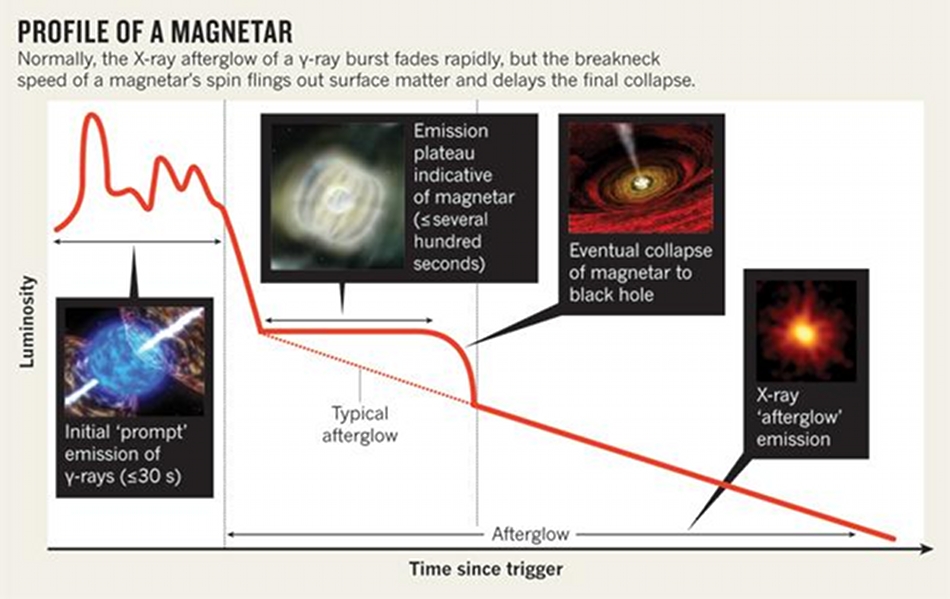
 Credit: prompt emission: NASA/Skyworks Digital; magnetar: NASA/Swift/Sonoma State Univ./A. Simonnet; black hole: NASA/CXC/A. Hobart; afterglow: NASA/Swift/S. Immler; Nature
Credit: prompt emission: NASA/Skyworks Digital; magnetar: NASA/Swift/Sonoma State Univ./A. Simonnet; black hole: NASA/CXC/A. Hobart; afterglow: NASA/Swift/S. Immler; Nature
Transmogrification
How are black holes formed? One way they can be created is via the titanic explosion of a very massive star. These events are sometimes called hypernovae. The birth cry of a newborn black hole is the dangerous Gamma-ray burst, the most powerful explosion since the Big Bang. Gamma-ray bursts last for a few minutes but can produce more energy in that brief time than the entire Milky Way Galaxy would produce in 100 years (at least, if we assume that no Gamma-ray burst goes off in the Milky Way in that time). We detect a few Gamma-ray bursts every month, which means that dozens of black holes are born each year. Or does it? Now, thanks to new data provided by the Swift and Fermi Space Telescope Gamma-ray burst detectors, the picture of gamma-ray burst/black hole formation has been refined. Both Swift and Fermi measure the time behavior of Gamma-ray bursts in exquisite detail. These time-histories, or "light-curves", as shown in the example above, show different stages with time. These stages are thought to represent transitional times in the death of the GRB. Astronomers who have analyzed a set of these GRB "light-curves" have found that, rather than declining in a (more-or-less) straight line, the emission from some GRBs shows a "plateau" in which the emission remains constant seconds or minutes before declining. Theorists suspect this plateau signals the birth of an intermediate object, a rapidly spinning, highly magnetized neutron star, or magnetar. The rapid rotation and extreme magnetic field of the magnetar helps thwart the relentless tug of gravity, at least for a brief period of time. Eventually gravity wins, the magnetar is crushed to a singularity, and a new black hole enters (or exits?) the Universe.
Published: November 8, 2010
Update November 15, 2010: the HEAPOW will return November 22
<
HEA Dictionary ● Archive
● Search HEAPOW
● Other Languages
● HEAPOW on Facebook
● Download all Images
● Education ● HEAD
>

Each week the HEASARC
brings you new, exciting and beautiful images from X-ray and Gamma ray
astronomy. Check back each week and be sure to check out the HEAPOW archive!
Page Author: Dr. Michael F. Corcoran
Last modified Tuesday, 27-Feb-2024 10:15:17 EST


